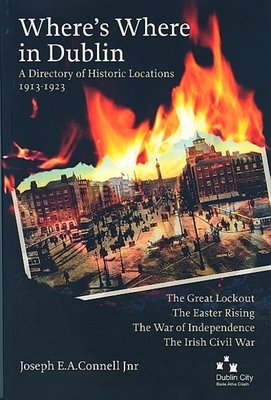Directory of Historic Locations
David Granville reviews Where's Where in Dublin: a directory of historic locations 1913-23 by Joseph E. A. Connell Jnr, Four Courts Press and Dublin City, ISBN 0946841 82 9, €15 pbk

LET'S BE clear, Josehh E A Connell Jnr's directory of Dublin locations with connections to the Easter Rising, the War of Independence and the Civil War is much more than a simple tourist guide. Indeed, its 226 pages offer a treasure trove of information and fascinating historical detail.
So, for example, the opening pages inform us that 45 buildings in Lower Abbey Street were burned or damaged during the Rising and that 32 Lower Abbey Street was from where Irish trade union leaders Thomas Farren and Thomas Johnson issued the call for a general strike in 1920.
Since the mid-1970s, numbers 10-16 D'Olier Street in Dublin have hosed the head office of the Irish Times (though the paper is soon to relocate to new premises). At the time of the Rising the then increasingly right-wing, pro-unionist newspaper - there are those who would argue that it hasn't changed that much - placed itself at the front of the queue of those who called for the execution of the leaders of the Rising.
However, in the years immediately prior to the Rising these buildings were connected with two very different types of publications. Number 12 D'Olier Street housed the offices of both Irish Freedom - Saoirse, run by Sean MacDermott until the paper's suppression in 1914 and Nationality, edited first by Bulmer Hobson, and then Arthur Griffiths and Sean T O'Kelly. The fact that their neighbour at number 13 was the Protestant Defence Association of the Church of Ireland, which was managed by a retired British army officer, must have made for one or two interesting encounters. And so on.
Joseph E A Connell Jnr, a lawyer and former California Community College lecturer by profession, has obviously studied the period with great thoroughness. Although currently living in Florida, he has been visiting Ireland regularly since 1960. He spend his summers in Dublin, where he puts his vast knowledge to good use guiding and informing visitors on 1916 walking tours around the city.
The author's attention to detail is continued in over seventy pages of appendices. These include details of addresses associated with Michael Collins, statements and key documents, and lists of organisations and garrisons, songs, plays, uniforms flags and emblems associated with the period. Detailed lists of those who fought in the Rising and where they were stationed and are also included.
If that doesn't satisfy you, there's a thorough bibliography covering manuscripts and printed primary sources, books, pamphlets, papers, periodicals and references to a couple of key internet resources. Clearly a labour of love, and possibly one of obsession, it's a book that destined to inform and fascinate readers for many years to come.
Connolly Association, c/o RMT, Unity House, 39 Chalton Street, London, NW1 1JD
Copyright © 2006 David Granville

